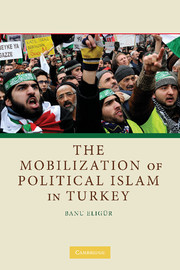Book contents
- Frontmatter
- Contents
- List of Tables
- List of Diagrams, Charts, and Boxes
- List of Acronyms
- Acknowledgments
- Preface
- 1 Introduction
- 2 Emergence of the Islamist Social Movement in Turkey
- 3 The Turkish-Islamic Synthesis and the Islamist Social Movement
- 4 The Malfunctioning State and Consolidation of the Islamist Social Movement
- 5 Organizational Dynamics of the Islamist Social Movement
- 6 The Soft Intervention of 1997 and the Islamist Social Movement
- 7 The Islamist Social Movement Today and Prospects for the Future
- Bibliography
- Index
5 - Organizational Dynamics of the Islamist Social Movement
Published online by Cambridge University Press: 01 June 2010
- Frontmatter
- Contents
- List of Tables
- List of Diagrams, Charts, and Boxes
- List of Acronyms
- Acknowledgments
- Preface
- 1 Introduction
- 2 Emergence of the Islamist Social Movement in Turkey
- 3 The Turkish-Islamic Synthesis and the Islamist Social Movement
- 4 The Malfunctioning State and Consolidation of the Islamist Social Movement
- 5 Organizational Dynamics of the Islamist Social Movement
- 6 The Soft Intervention of 1997 and the Islamist Social Movement
- 7 The Islamist Social Movement Today and Prospects for the Future
- Bibliography
- Index
Summary
This chapter examines the second phase of the development of political Islam in Turkey, from 1991 to the present. According to the political process model (PPM), once a movement is underway, organizational dynamics come to occupy center stage, while framing processes continue to shape the development of the movement. As a result of the Turkish-Islamic Synthesis policy (TIS, the first political opportunity structure), the Welfare Party (WP) established a strong organizational network (formal and informal) in the 1980s that would enable the party and its successors to frame the malfunctioning state in a manner that mobilized the electorate against the secular-democratic state in the 1990s. By the 1990s, a parallel Islamic socioeconomic sector, comprising the Islamist business class and Islamist intellectuals, emerged next to the WP party apparatus.
In their study of the political framing process, Gamson and Meyer argue the media play a crucial role in “the construction of meaning and the reproduction of culture.” Thus, the media's “openness to social movements is itself an important element of political opportunity.” Yet, in the Turkish case, it was not the openness of the media that allowed Islamist entrepreneurs to carry out a successful “framing” effort; it was the media's neglect of the Islamist movement that created space for Islamist entrepreneurial activities. The media did not pay sufficient attention to the WP's political rhetoric and activities until the mid-1990s.
- Type
- Chapter
- Information
- The Mobilization of Political Islam in Turkey , pp. 182 - 213Publisher: Cambridge University PressPrint publication year: 2010



